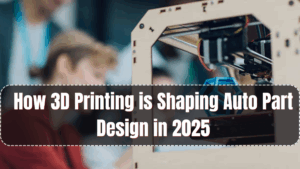The world of automotive manufacturing is undergoing a transformation in 2025, and at the forefront is 3D printing—also known as additive manufacturing. Once used mainly for prototypes, 3D printing for auto parts is now reshaping how designers, garages, and OEMs approach vehicle development, maintenance, and customization.
With its ability to deliver faster, cost-efficient, and eco-friendly solutions, 3D printing is no longer an experimental technology—it’s a core part of the automotive industry’s toolkit.

Why 3D Printing Has Gained Momentum in 2025
Several factors have accelerated 3D printing adoption across the auto sector:
-
Customization demand from EV startups, car modifiers, and sportscar engineers
-
Supply chain disruptions that pushed manufacturers toward in-house, on-demand part production
-
Advancements in printable materials like carbon-fiber composites, aluminum alloys, and flexible polymers
-
Government incentives for sustainable manufacturing
In 2025, even small auto garages use compact 3D printers to produce rare or discontinued parts on-site within hours.
Top Use Cases of 3D Printing in Auto Design
Here’s how 3D printing is changing auto part design across various categories:
-
Interior Components: Custom air vents, dashboard trims, phone holders, and control knobs
-
Prototype Models: Concept car mockups, component testing, and fit validation before mass production
-
Replacement Parts: Tail lights, brackets, cooling ducts, and housing units—especially for older or imported vehicles
-
Performance Mods: Lightweight spoilers, racing intakes, custom exhaust tips using carbon-infused materials
Auto manufacturers are using 3D printing not only to create parts but to redesign them for better aerodynamics, reduced weight, and improved heat management.
Sustainable Design with Additive Manufacturing
3D printing significantly reduces material waste, energy use, and logistical emissions. Here’s how:
-
Only the exact amount of material is used—unlike traditional subtractive methods
-
Parts can be printed on-demand at the service location, reducing shipping and warehousing
-
Recyclable and biodegradable materials (like PLA blends) are increasingly used for non-structural parts
-
Tool-less production eliminates the need for costly, energy-intensive moulds and dies
These aspects make 3D printing a major contributor to green manufacturing in the auto industry.
How Garages and Designers Benefit from 3D Printing in 2025
In 2025, local mechanics and design students have access to affordable desktop 3D printers that cost under ₹1 lakh. Here’s what they can do:
-
Reverse-engineer broken parts using 3D scanning tools
-
Offer customization services to clients (logo-etched trims, color-matched gear knobs)
-
Reduce wait time for imported spare parts
-
Experiment with new designs and car mods without expensive prototypes
Auto design colleges now include 3D CAD modeling and printing as part of their core curriculum.
Automakers Embracing Full-Scale 3D Integration
Several global and Indian manufacturers have adopted 3D printing as part of their main production process:
-
Ford and BMW use 3D printing for tools, jigs, and even metal engine parts
-
Tata Motors and Mahindra print rapid interior prototypes for their EV divisions
-
Startups like Pravaig Dynamics in India use 3D-printed body panels to lower vehicle weight
In fact, some concept EVs in 2025 are up to 30% 3D printed, marking a new phase in how cars are imagined and assembled.
FAQs
What is 3D printing used for in cars?
In 2025, it’s used for prototyping, interior customization, spare parts production, and performance modifications.
Is 3D printing cost-effective for car parts?
Yes. For small batches, discontinued parts, or customized components, 3D printing is more affordable and faster than traditional methods.
Can garages in India use 3D printing?
Absolutely. Many local garages now use desktop 3D printers to make rare parts and trims on-demand.
Are 3D-printed parts durable enough for regular vehicles?
Yes, when printed using automotive-grade materials, these parts can last as long as traditionally manufactured ones for non-load-bearing components.
Click here to know more.
